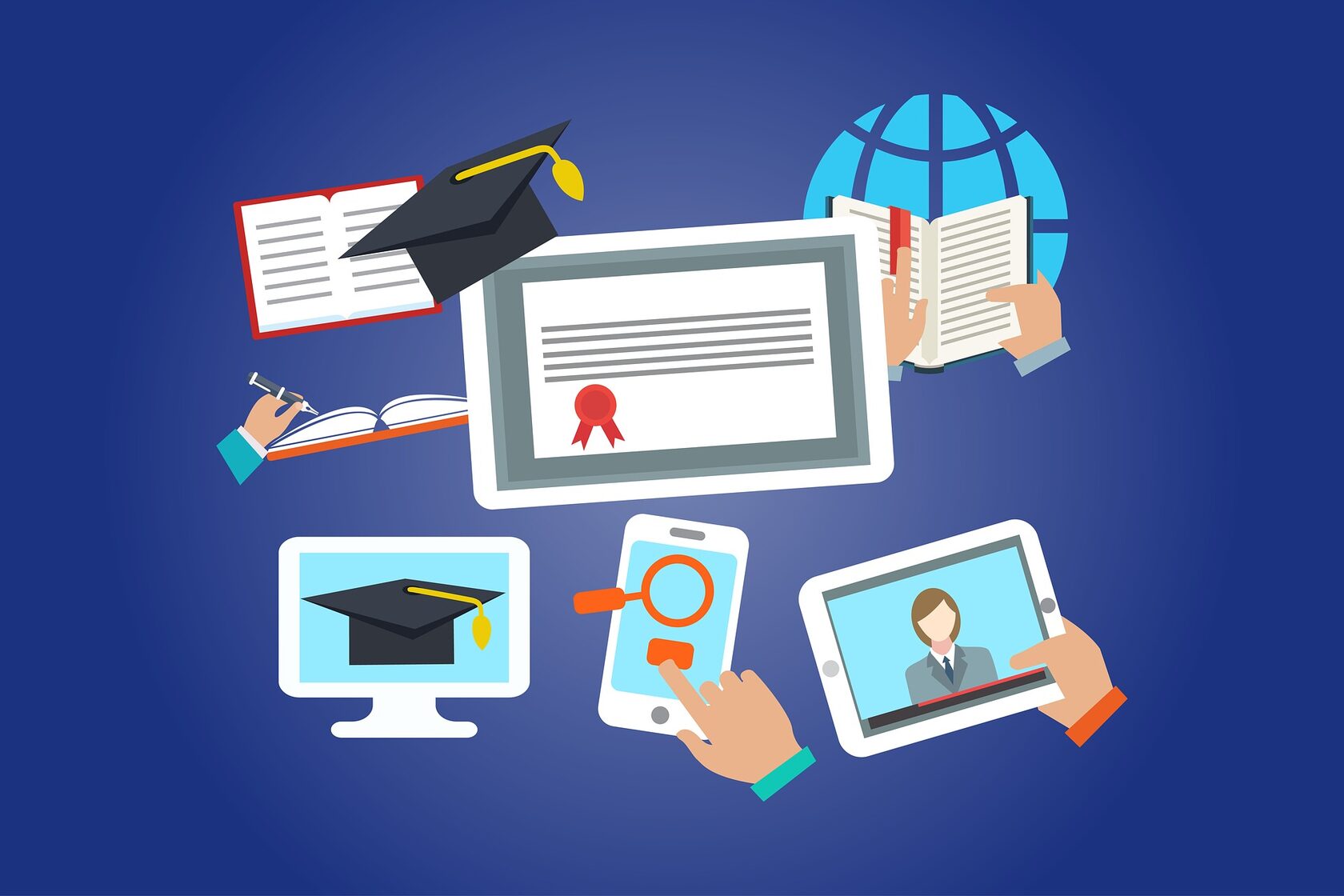Educational technology has quickly become a paramount element in every learning stage from primary schools to universities. It not only helps to make lessons more illustrative, informative, and engaging, but also allows for improved scalability and overall effectiveness of education. In this article, we will explore the top technological trends in teaching and learning that you should be aware of to provide your students with the best educational experience.
What Are the Top 10 Trends of Education Technology in the Coming Years?
Educational technology, also known as EdTech, is continuously evolving and changing at a rapid pace. Every year, many innovative tools and applications are being developed to improve and facilitate both the teaching and learning process. To help you stay ahead of the curve and improve your teaching methods, we have prepared a list of the top 10 innovative trends in educational technology. Keep reading to find out the details.
1. Remote Learning
Online learning has become a buzzword in the modern world. Educational institutions are starting to offer more online learning programs, so a growing number of students can take advantage of the convenience and flexibility of online examinations and various courses. According to the statistics, only the US remote education market is expected to grow by $12.81 billion between 2020 and 2024.
E-learning is one of the main trends in modern education, and has gained enormous popularity due to its considerable benefits. Here are some of them:
- Accessibility. Online courses and exams can be accessed from anywhere in the world, making education more accessible than ever before.
- Flexibility. E-learning not only allows students to study from the comfort of their homes but also provides them with an opportunity to complete educational courses at their own pace, introducing a more customized learning experience.
- Cost-efficiency. Remote learning can be a great way for students to save money on tuition and other associated costs. Educational institutions, in turn, don’t have to hire as many specialists and pay as many administrative costs.
When it comes to online education, it’s important to mention online proctoring solutions that ensure the academic integrity of digital courses and exams, as well as protect the reputation of educational institutions. Nowadays, there is a big choice of proctoring software, thus it’s easy to find the one that will comply best with the goals of a particular learning program, test, or assignment. Remote proctoring solutions are usually divided into three main groups: live remote, recorded, and AI proctoring, each of which offers a set of features to increase the effectiveness of the learning process and eliminate student dishonesty.
- Live remote proctoring implies that a human invigilator monitors test-takers in real-time via their webcam and microphone. This type of proctoring technology will be more suitable for educators who want to establish additional control or communication with their students during an important assessment.
- Recorded proctoring means that all the examination process is recorded, analyzed by a special software, and sent to a human proctor for additional review when the test was already ended.
- AI proctoring doesn’t require a human observer. A special AI-based software monitors and analyzes video and audio streams and makes conclusions about the integrity of the examination.
There is no doubt that online learning as a trend will continue growing in the future. Even more students and organizations will take advantage of this convenient and affordable form of education.
2. Tech-Enabled Immersive Learning

Extended reality, which combines virtual reality (VR), augmented reality (AR), and other solutions used to extend the real environment is another fast-growing trend in the educational sphere. These technologies are aimed at making the learning process more immersive and engaging. Before considering the importance of AR and VR, let’s explore the difference between these two concepts.
- Virtual reality is a simulated environment created by a computer. The illusion of reality is usually achieved with the help of special devices and systems, such as headsets, special gloves, etc.
- Augmented reality is a combination of the real and digital world. In contrast to VR, it doesn’t require special equipment, so students can enter it even through a mobile phone application.
Extended reality can be implemented in many educational fields. For example, medical universities can use the visual power of AR and VR to explain to their students the anatomy of the human body, history students can use VR headsets to walk in ancient towns, future architects can create a 3D model of their design, and much more.
AR/VR is a consistent trend in education that is expected to gain widespread adoption in the near future. According to statistics, in 2020, the global share of virtual reality in the education market was $6.37 billion, and by 2026 it is expected to reach $32.94 billion, experiencing a growth of 39.7% during this period. Here are some of the numerous reasons for the immense popularity of these technologies:
- AR/VR provides an immersive learning experience.
- Educators can benefit from an easy monitoring process.
- It makes e-learning more engaging and fosters self-learning.
- Extended reality can be used in a wide variety of educational fields (humanities, business, sciences, engineering, medicine, etc.).
- It is an efficient solution for students with special needs.
3. Innovative K-12 Homeschooling Startups
Homeschooling has become another popular trend in education, especially when parents were trying to find studying alternatives for their children during the COVID-19 pandemic. Nowadays there is a great variety of cutting-edge K-12 homeschooling startups offering flexible learning programs for various needs, from supplementary to full-time schooling. They usually come with a customizable curriculum, a wide choice of subjects, a great collection of educational content, and other technical features, helping to make the online learning process more efficient and involving.
4. Artificial Intelligence (AI) in Learning
The potential of artificial intelligence (AI) is vast and far-reaching. This is why this technology has become an essential part of many sectors of our life. The definition of artificial intelligence implies that it can self-learn and make decisions. In education, these AI features can be implemented to improve learning programs, develop more effective ways of assessing students, and more.
Apart from self-learning algorithms, AI can offer educators the benefit of automation. This means that they can delegate all repetitive and cumbersome tasks to special AI-based software, thus getting more time for creative assignments.
Last but not least, AI solutions can assist in adaptive learning, which is an educational process that provides students with a personalized learning experience and adjusts to their needs. AI-based software asks students to take a questionnaire, calculates their results, and then offers the most suitable course of action to reach the learning objectives.
5. Gamification
Gamification means using game-based elements in non-game contexts. In education, it has been used to improve engagement and motivation among students. By incorporating game elements such as points, races, and level-ups, educators can make learning more interactive and resultative. Some examples of game-based learning involve:
- Minecraft: Education Edition. Teachers know that many students love playing video games. So, why not take advantage of this? Minecraft comes with ready-made lesson plans, downloadable teaching resources, and other features helping educators integrate gaming into their classrooms.
- Kahoot. This application lets teachers create online tests and quizzes in a matter of minutes, which students can easily enter via link on their mobile phones.
- Quizlet. This learning app allows you to create quizzes, flashcards for memorizing new information, word races, tests, and more.
The success of gamification depends on its application. When used reasonably, it has the potential to enhance the learning experience for students of all ages.
6. Google Everything

- Google Docs, Forms, Sheets, and Gmail are necessary tools for learning routines, helping students prepare their assignments and communicate with educators.
- Google Scholar helps students search for academic papers and journal articles from reputable sources.
- Google Classroom allows for student-teacher interaction. There, it’s possible to submit assignments and get feedback from teachers.
- Google Translate lets students quickly translate foreign language texts.
7. Accelerating Investments in EdTech
Growing investments are the driving force of EdTech development. According to Edsurge, in 2020 alone, the US EdTech sector received $2.2 billion, experiencing a surge of around 30% from 2019. One of the reasons for such considerable attention to the education technology sphere was the COVID-19 outbreak. However, as the experts say, the trend of accelerating investments in this sphere will continue. HolonIQ expects that at least $87 billion will be invested into EdTech over the next decade.
8. Lifelong Learning
Rapid technological development has dramatically changed our attitude toward studying. Some decades ago, it was believed that education ended when you finished school or university. Nowadays, people tend to see learning as a lifelong process. This shift can be explained in various ways. However, one of the most important reasons is that in a rapidly changing world, it is increasingly important to keep up with new developments, especially in the professional field. Otherwise, it will be difficult to stand out among numerous competitors and get a good job offer.
9. Blockchain
Although blockchain technology was initially associated only with Bitcoin and cryptocurrencies, it has proven to be applicable in many different spheres. In education, it can be implemented for various purposes, such as security, data storage, verification processes, etc. For example, blockchain-based digital badges could be implemented to verify student achievement and certify their competencies. Moreover, it could track educational materials or ensure secure records of academic transcripts.
10. Accessible Education
Accessible education is one of the main goals of modern society. According to the UNESCO report from 2019, 58.4 million of the world’s 787 million children of primary school age don’t have an opportunity to get even basic education. Although the situation has significantly improved in the last decades, it’s still far from ideal. Remote learning and other technologies are expected to help in resolving this problem. In addition, several initiatives have been launched to provide educational opportunities for people who might not otherwise have access to them. One of them is the Open Educational Resources movement launched by UNESCO in 2019, which aims to make learning materials available online.
Will Online Proctoring Be Still Relevant in the Future of Education?
Online learning is one of the most consistent trends in the educational sphere. However, it’s important to remember that both classroom and remote studying are based on the concept of academic integrity, protection of which has always been a matter of great concern for the educational community. Thus, online proctoring will not only stay relevant in the future but also increase in popularity since it has proven to be an efficient instrument to eliminate student dishonesty and protect the reputation of educational institutions in the digital environment.
Conclusion
Educational technology has significantly evolved in recent years. Modern students can enjoy the interactive and engaging learning experience with extended reality and AI technologies while educators can take advantage of blockchain and cutting-edge proctoring solutions to improve the teaching and monitoring processes.
It’s crucial to understand that although some technological trends have already become an integral part of the educational environment it is still the beginning. With good investment, EdTech will receive wider adoption, helping educators ensure that they are effectively preparing their students for the future.
FAQ
What are the new trends in education?
Modern education has significantly evolved, especially under the influence of the COVID-19 outbreak. Some of the fast-growing trends in this sphere include but are not limited to e-learning, AR/VR features for immersive studying experience, AI-based solutions for personalization and automation, blockchain technology for robust security, gamification for improved student engagement, and more.
What are the current issues in educational technology?
One of the most significant challenges in education technology is resistance to changes. Although worldwide digitalization has revealed the importance and convenience of innovative technologies, the educational sphere is still quite reluctant to adopt them. Another issue is the professional level of educators, who don’t usually have enough skills and experience to incorporate cutting-edge solutions in their teaching process.




